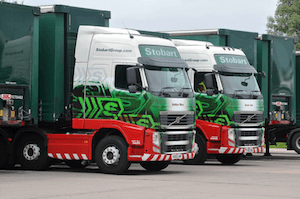Businesses that rely on transportation utilize fleet management to control costs, productivity, fuel management, and compliance. As such, fleet management is comprised of several different tasks to keep vehicles and operations running smoothly and efficiently. Fleet vehicle management best practices involve the use of technology and software solutions to help reduce costs, enforce driver safety, minimize risk, increase productivity, and schedule preventive maintenance to reduce downtime.
Because fleet management is all-encompassing, it is difficult to define. Essentially, fleet management refers to the processes involved in overseeing a fleet of vehicles and related assets, as well as optimizing efficiency while minimizing costs and risk. Thus, fleet managers are responsible for controlling costs, maximizing profitability, and reducing fleet vehicle risks.
The benefits of fleet management are multi-fold. Namely, effective fleet vehicle management yields fuel savings, increases productivity, improves customer service, and provides real-time visibility.
 reduce fuel costs by 20%-25%. These tracking solutions alert you to idle time per vehicle and deliver idle time averages across your fleet. They also empower you to monitor fleet performance, track how improvements affect idle time, and help educate drivers about the need to reduce idle times.
reduce fuel costs by 20%-25%. These tracking solutions alert you to idle time per vehicle and deliver idle time averages across your fleet. They also empower you to monitor fleet performance, track how improvements affect idle time, and help educate drivers about the need to reduce idle times.GPS tracking solutions also reduce fuel by optimizing routes. Typically, companies that adopt these solutions reduce total miles driven by 5%-10%. Plan more efficient routes with access to maps detailing the location and destination of each fleet vehicle. You also can access driver and vehicle information while monitoring traffic and weather. Best of all, you can improve efficiency by sending the vehicle closest to the destination via the most direct route to improve customer service.
One of the best ways that telematics solutions make fleets more productive is in tracking maintenance. Fleets can’t operate when vehicles are in for unscheduled maintenance or break down, and telematics helps you be proactive with preventive maintenance. You’ll know how many hours your vehicles run and get real-time insights into engine hour data to optimize preventive maintenance schedules. You’ll also know exactly when to replace vehicles.
To learn more about fleet preventive maintenance, read our step-by-step guide on how to implement a fleet preventive maintenance plan and it comes with a printable checklist! Also, check out our big list of the best fleet maintenance software systems.
Fleet management GPS tracking solutions also help companies get drivers to appointments on time. You deal with new or canceled appointments regularly, but you don’t have to lose productivity because of them. Using real-time locations, you can send drivers to customers on time and serve more customer needs, despite unplanned schedule changes. You’ll also give customers better driver ETAs and avoid frustrating them with vague or inaccurate driver information when you use a GPS tracking solution as part of your fleet management strategy.
Any time you have to manage fleets, drivers, costs, and schedules, you face challenges. While technology and software solutions eliminate many challenges for fleet managers, you still need to solve problems quickly. Some of the largest fleet management challenges include driver safety and productivity, cost-reduction initiatives, and fuel price volatility.
Driver safety– Effective fleet management prioritizes driver safety. To address this challenge, rely on safety education programs, regulations, and predictive analytics to work toward eliminating preventable  accidents.
accidents.
Cost-reduction initiatives– Because of changing budgets and forecasts, it is difficult for fleet managers to reduce costs. The right software and tools can help, but fleet managers need the experience to become skilled at forecasting.
Fuel price volatility– Even the best cost-reduction strategy can fail because of the volatility of fuel prices. Taking steps to increase fuel efficiency, decrease idle time, and optimize routes help reduce fuel consumption, but fleet managers cannot guarantee accurate fuel forecasts.
Fleet management involves operational cost-effectiveness, vehicle maintenance, driver and asset management, vehicle safety and compliance, and operational efficiency. Effective fleet management helps you reduce fuel costs, optimize routes, increase productivity, and enhance customer satisfaction. Fleet managers also face the challenges of ensuring driver safety, reducing costs, and forecasting fuel prices.
Fleet management involves the creation of a complete system for organizing groups of cars, vans, trucks, trains, or marine vessels that are used to transport goods. For this system to work properly, a business or government entity must establish set practices and clear expectations that are standardized. The core components of a fleet management system are:
A fleet manager is responsible for overseeing every aspect of fleet operations. Fleet managers oversee fleet vehicles and drivers, ensure driver safety, optimize fleet costs and efficiency, manage fuel programs, and manage regulatory compliance. They also work in collaboration with other department managers to ensure that the necessary vehicles are available and operational to allow for on-time deliveries and distribution. Here’s a list of common fleet manager tasks and responsibilities:
There are several ways to improve your fleet vehicle management processes and improve fleet efficiency, from implementing fleet tracking best practices to implementing the right fleet management software that includes asset management tools for efficient fleet monitoring. Here’s a look at proven strategies to improve fleet management.
Manual fleet tracking methods are time-consuming and prone to inaccuracy. Fleet tracking software enables you to optimize fleet tracking processes by storing all vehicle and driver information in a central location, track vehicle locations in real-time, manage driver safety records, and track driving behavior to identify risky behaviors and improve fleet and driver safety. With easy to understand dashboards, automated reporting, and data analysis features, fleet tracking software provides essential insights and tools to streamline documentation and management processes.
Integrating your fleet management software with other tools such as GPS devices, ELDs, fuel cards, and telematics provides a more comprehensive view of everything that’s going on with your fleet. For example, if your drivers use an app to conduct digital vehicle inspections, integrating this data with your fleet vehicle management system allows fleet managers to proactively identify and address safety concerns and potential vehicle issues. If you use a separate solution for fleet maintenance management, integrating it with your fleet tracking solution helps you better manage preventive fleet maintenance activities based on vehicle condition, miles traveled, and other data.
GPS-based fleet tracking systems enable fleet managers to assess the efficiency of the routes drivers are taking and identify the most efficient routes to minimize costs. These systems also allow for tracking metrics like idle time and speed, which can help to pinpoint target ranges for optimal economic efficiency. Conducting route analysis and integrating Google Maps data enables fleet managers and drivers to identify the fastest route to a destination based on traffic patterns and other data.
Regulatory compliance is a key component of effective fleet management. In addition to monitoring driving behaviors to improve safety, fleet managers should also leverage tools to streamline processes like hours of service (HOS) documentation, vehicle inspections, monitor the statuses of licenses and permits, and provide a central storage location for easy access to the documents fleets must have on hand at all times, such as HOS records, proof of insurance, records on vehicle inspection, maintenance, and repairs, driver training records, incident and accident reports, and other documentation.
Advances in technology have radically transformed the fleet management industry. Even with this incredible progress, new innovations are being made each year to push the industry further. These are some of the most promising trends that could add significant value to fleet management practices.
Looking for how to improve your fleet vehicle management? Try implementing a fleet management system. Not sure where to start? Read through our recommendations of the best fleet management software to find the right fleet management solutions for you.
Images via Flickr by Raymondo166and Raymondo166
Our sales engineers are experts in automatic asset tracking, tagging and identification,a nd can answer all your questions. Get in touch now.
Lets Talk ›